What are railway gradient posts?
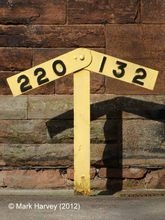
ex-Midland Railway Co.
gradient post.
Gradient posts are installed beside railway lines wherever there is a change in the gradient (rate of ascent / descent) of the trackbed. Each gradient post within the SCRCA has (or originally had) two arms, one either side of a central support post (see Image 1). The angle of each arm is set to give a clear indication of the direction of the gradient:
- The arm is angled upwards if the trackbed rises in that direction.
- The arm is set horizontally if the trackbed is level.
- The arm is angled downwards if the trackbed falls away from the location of the gradient post.
The angle of the arm does not accurately reflect the severity or otherwise of the gradient. That is indicated by the letters and / or numbers painted, fixed or cast on the arm on the side facing the running lines (tracks):
- If the track is level, the word 'Level' or the letter 'L' is shown.
- If there is a gradient, the gradient is given as a ratio in the form '1 in nnn' or just 'nnn' (the latter version being the most common within the SCRCA). The smaller the number ('nnn'), the more severe the gradient.
Examples of two standard Midland Railway Company designs can be found within the SCRCA:
- A timber variant (see Figure 1). This is believed to be the earlier of the two SCRCA variants and an example can be seen on the 'Down' platform at Appleby Station.
- A metal variant (see Figure 2). This version is believed to have been introduced later than the timber versions, probably to reduce maintenance costs arising from the need to replace rotten posts / arms. An example can be seen on the 'Down' platform at Armathwaite Station.
A later (concrete) variant is also common within the SCRCA (see Gradient Post - Other). These are believed to date from the late LMSR / early BR periods.
For more photographs of gradient posts within the SCRCA, see Structure Type Definition for Gradient Posts.
Details of all the gradients posts within the SCRCA can be accessed via the Gazetteer by setting the 'Location Type filter to 'Gradient Post'.
Why are railway gradient posts necessary?
The short answer is "because most of Britain's railways are not flat". Rather, they undulate significantly, as illustrated by the gradient diagrams below (see Figures 3, 4 & 5).
The drivers and firemen working steam locomotives need to have a detailed knowledge of the line and its gradients so they can ensure that enough steam is available to power the locomotive at all times, but without wasting coal and / or water.
In the past, the guard on unfitted freight trains needed a similar level of route knowledge so that, just before and immediately after each significant change in gradient, he could manually engage / disengage the brakes in the guards van (and, where necessary, on individual wagons along the length of the train).
The Settle-Carlisle Railway was built with a 'ruling' gradient of one in a hundred (1 : 100). This means that the steepest sections of the route climb or fall one unit (e.g. one foot or one metre) for every one hundred of the same units travelled horizontally. Many sections of the Settle-Carlisle line have shallower gradients and some sections are level. However, the infamous 'Long Drag' is an almost continuous thirteen mile 1 in 100 climb from Settle Junction to the south end of Blea Moor Tunnel (see Figure 3). In steam days, this presented an exceptionally tough challenge for both the locomotives and their crews.
The drivers of modern diesel and electric trains still need to be aware of the direction and severity of gradients, especially when driving locomotives that are hauling heavy freight trains.
Figures
Tip: To view a larger version of an image, click / tap on its thumbnail.
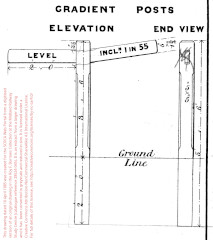
See acknowledgements below for further details.
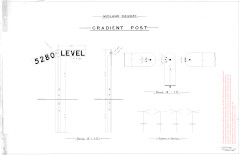
See acknowledgements below for further details.
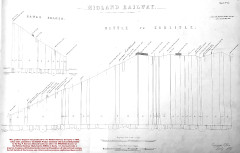
See acknowledgements below for further details.
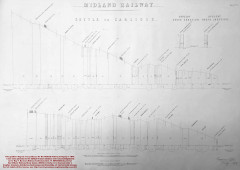
See acknowledgements below for further details.

See acknowledgements below for further details.
Acknowledgements
Text and photographs by Mark R. Harvey (© Mark R. Harvey, 2017-2020).
The author would like to thank Dave Harris for his assistance with this article and for providing digital copies of the following items from the Roy F. Burrows Midland Collection at the Midland Railway Study Centre:
- Figure 1: This is an extract from a scale drawing (item reference 28524-045) dated 10 April 1885 featuring Midland Railway Company standard designs for gates, stiles, fencing and timber gradient posts. The extract used for this article shows only the gradient post.
- Figure 2: This scale drawing (item reference 28524-125) dated January 1894 illustrates a Midland Railway Company standard design for metal gradient posts.
- Figures 3 & 4: These two gradient diagrams were produced by the Engineer's Office of the Midland Railway Company in Derby in 1876 and they form part of a bound volume (28 sheets and an index) entitled "Midland Railway Gradients" (item reference 20542).
- Figure 5: This gradient diagram was produced on 31 August 1932 and amended in February 1947 (item reference 20143). It includes track layout enlargements for Settle, Garsdale Junction, Appleby, Langwathby, Lazonby & Kirkoswald, Petterill Bridge and Carlisle.
In all cases, the original images have been modified by converting them to greyscale and increasing the contrast (to improve clarity / readability) and by reducing their size (to speed-up page-loading and downloading times without adversely affecting readability) . The original images and the modified versions used on this webpage are all licensed under a Creative Commons Attribution-NonCommercial-ShareAlike 4.0 International License. For full details of this license, see:
http://creativecommons.org/licenses/by-nc-sa/4.0/
